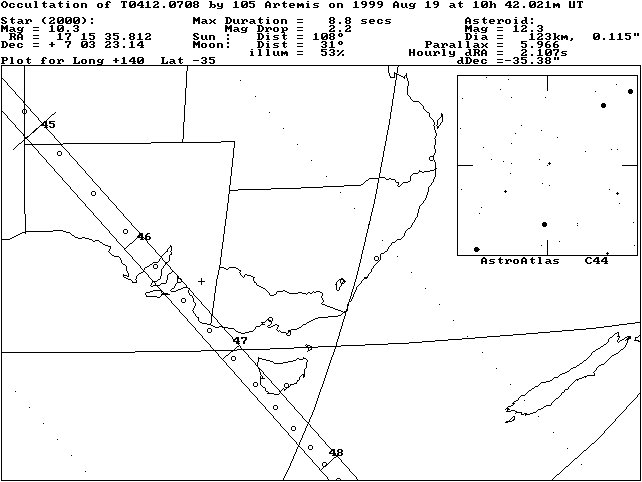ASTROMETRIC UPDATE:
OCCULTATION BY (105) ARTEMIS - 1999 AUGUST 19
CHECK THIS PAGE REGULARLY FOR FURTHER UPDATES AND CHANGES TO THE TRACK.
YOU MUST RELOAD THIS PAGE USING YOUR BROWSER'S
RELOAD/REFRESH BUTTON TO OBTAIN UPDATES!
PATH UPDATED 17 AUGUST 1999
[Prediction by Edwin Goffin]
[Prediction using OCCULT software]
Both the Goffin and OCCULT predictions suggests a path across southern Tasmania and Adelaide.
UPDATE: 17 August 1999
This prediction update has been computed by Jan Manek based on astrometry from USNO/Flagstaff and Table Mountain Observatory. The Tycho position of the star has been used.
Summary:
The updated track is entirely co-incident with the nominal path, the track crossing western Tasmania, and Adelaide, South Australia.
Event time is about 20 seconds later than the Goffin and OCCULT predictions. Updated time is about 10h 46.2m for Adelaide.
As the path runs over the Adelaide area, there is every possibility of extensive coverage of this event. Medium to large telescopes will probably be needed as the star is faint.
The path also crosses Tasmania with Hobart just outside the eastern edge. A shift of only one path width to the east would place Hobart and Launceston directly in the path, along with Port Augusta, SA. Geelong in Victoria would also lie close to the edge of the path.
Observers with mobile telescopes are strongly encouraged to expand the region of coverage around Adelaide, within the Yorke Peninsula and (if possible) on Kangaroo Island. Observations are also strongly encouraged from the region of Mt Gambier, and from regions of western Victoria.
THE EVENT AT ONE GLIMPSE:
- Date and approx. UT time of event: August 19, 1999 @ 10:46.2 UT (Adelaide)
- Magnitude of target star: 10.3
- Magnitude drop [mag]: 2.2
- Estimated maximum duration [s]: 8.8
- Path description: Across Adelaide and western Tasmania.
The Occultation Path:
- Approximate width [km]: 130
- Uncertainty [path widths]: 1
- Uncertainty in time [s]: 10
- Map: See below
- Remarks: Uncertainities are given on the basis of the nominal errors in the observations.
- Circles along the path are OCCULT calculated exact centerline points.
Data for the target star:
- Name: TYC 0412 00708
- J2000 position [h,m,s; o,',"]: 17h 15m 35.812s; +07o 03' 23.14"
- Position source: TRC 1.0
- Estimated accuracy ["]: 0.06" (0.04", 0.04")
- V mag [mag]: 10.29
- B-V [mag]: +1.08
- TYCHO gives quality flag 4 (high) with a 'no investigation for duplicity' flag.
- The target star is 7.3 degrees SW of the 2.1 mag star alpha Ophiuchi in the northern part of the constellation. The target star is only 2.2' SE of 9.6 mag SAO 122212, or 6.4' SW of 9.3 mag SAO 122223, both of which can serve as comparison stars. These three stars form a nice triangle.
Data for the minor planet:
- Number, name: (105) Artemis
- Approx. diameter [km]: 123
- Source of used astrometry: USN0/Flagstaff (Ron Stone) + TMO (Bill Owen)
- Number of used observations: 51 USNO + 10 TMO
- Number of rejected observations: 3 USNO
- Time covered by the observations: 1997 11 22 - 1999 08 12
- RMS residuals ["] (RA,DE): 0.08", 0.07"
- Estimated positional accuracy at epoch of event ["]: 0.06"
- Remarks: Observations cover almost two years and are of excellent quality.
Data for the event:
- UT date and time of least geocentric approach: 10:42:01 UT
- Approx. V mag of minor planet at event [mag]: 12.3
- Geocentric parallax of minor planet ["]: 5.966
- Magnitude drop [mag]: 2.2
- Estimated maximum duration [s]: 8.8
- Apparent motion of minor planet ["/h]: 47.29
- Angular distance to moon, phase of moon [deg,%]: 31, 53%
- Update computed by: Manek

IMPORTANT NOTE!
Astrometric updates such as these should not be taken as definitive, but rather only as an indication of where the true track may lie relative to the original predicted track. Observers must bear in mind that later astrometry, in which the target star is measured in the same field as the asteroid, may still reveal substantial changes to the predicted track and time of the event. For this reason it is most important that observers far from the predicted track still monitor the event.
Use these links for further information:
[Planetary Occultations]
[Using the Predictions]
[Observing Details]
[Timing Details]
[Reporting Details]
[Report Form]
[Asteroid Occultation Results]
This page may have been updated since 17 August 1999.
Hit your browser's RELOAD button to get the latest version.
[Site Map]
[What's an Occultation?]
[Total Occultations]
[Grazing Occultations]
[Planetary Occultations]
[Jovian Satellite Eclipses]
[Timing Occultations]
[Reporting Observations]
[Coming Events]
[Software]
[About Us]
[Publications]
[Membership]
[Links]
[Top of Page][Return to Home Page]
